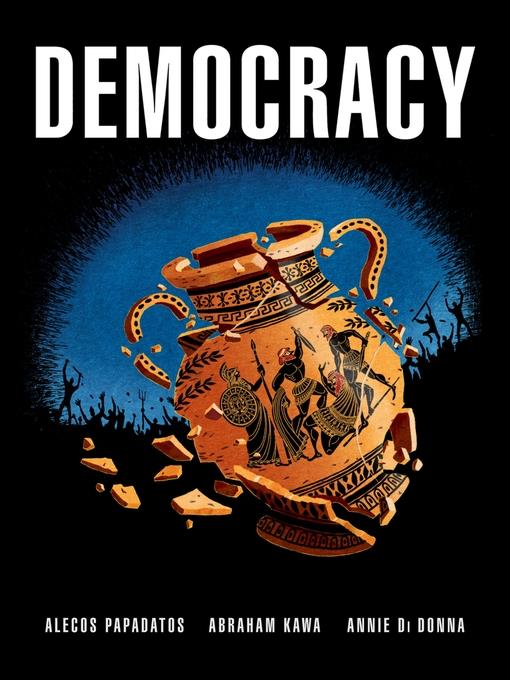
Democracy
کتاب های مرتبط
- اطلاعات
- نقد و بررسی
- دیدگاه کاربران
نقد و بررسی

Starred review from August 17, 2015
Papadatos and Di Donna, artists of the acclaimed and bestselling Logicomix, team with writer and academic Kawa for an incisive and entertaining visual history of the roots of democracy. This journey is a saga comparable to epics such as Frank Miller’s 300 and Eric Shanower’s Age of Bronze, with a touch of Jack Kirby’s wondrous mythological civilizations. Greek hero Leander functions as the entry point, giving the book striking immediacy and personality as it traces the historical transition from his society’s utter faith in the Greek gods to the beginnings of modern politics. Papadatos’s lively and energetic art illuminates battles, alliances, political machinations, and vivid personalities, and Di Donna’s intense coloring is gloriously rich without a touch of gaudiness. For those interested in further background, the extensive back matter features useful commentary on both legendary and historical figures and concepts. Like Logicomix, this is a brilliantly realized stealth education.

July 1, 2015
A celebrated Greek writer and illustrator teams up with a cultural studies theorist and an animator to tell the story of the ancient origins of Athenian democracy. Best known for the graphic work Logicomix (2008), about a foundational quest in mathematics, Papadatos, along with Kawa and Di Donna (who also contributed to Logicomix), opens the tale in 490 B.C.E. with the Athenians at war with the Persian tyrant Darius. The book's main character and moral voice is Leander (of the ancient Greek myth of Hero and Leander), a young man with a talent for art who spends his days painting the stories of Greek mythology. In much the same way, Papadatos and his collaborators paint a vivid picture of ancient Athens with all its conflicts, conspiracies, old gods, and new greed. In time, Leander falls in with the aristocrat Cleisthenes, one of a triumvirate credited with the birth of democratic ideals, along with the statesmen Solon and Ephialtes. "Maybe something's coming," Cleisthenes says to the crowd. "Something that will crystallize Athenian culture into an entirely different form, one better suited to survival." Leander serves as the chorus, but he also stands for the common man as he struggles to understand how these new ideas are necessary to end the old system of tyranny and fear. This is fairly heavy history, but by presenting it in the graphic form, the creators leave the story open to interpretation while at the same time making a vital moment in world history accessible for younger readers. Kawa explains their thinking in a thoughtful coda. "We wanted to tell the story of people like us, who, throughout history, have to face the tidal waves brought on by...cataclysmic events-and make sense of them." World history teachers would do well to make use of this book, which includes a short afterword with commentary about the book's central characters, important sites, and other aspects of Athenian culture. A colorful love letter to Greek history.
COPYRIGHT(2015) Kirkus Reviews, ALL RIGHTS RESERVED.

Starred review from August 1, 2015
In 490 BCE, Leander, an Athenian painter of fine pottery, tells three comrades the story of how he comes to be with them, awaiting sunrise and battle with the Persians on the plain of Marathon. His family shattered and dispossessed by a seizure of tyrannical power, Leander became an attendant of the treasury at Delphi before pursuing his calling in Athens, which had reverted to factional rivalry in which one side wanted to restrict and the other to greatly expand Athens' assembly of citizens. Like his father, Leander follows the leader of the latter, Cleisthenes, since often called the father of democracy. There's a love story in the mix, too, between Leander and Hero, beginning just before he first goes to Delphi and she is sent there as a priestess-in-training. Coauthors Papadatos and Kawa have created a genuine historical novel, in which fictional protagonists interact credibly with historical figures, and both kinds of characters are depicted as people of their time, not the present. They don't preach for democracy nor psychologize religion when Leander hears the godsor, he wonders, is it his conscience? Also draftsman of the piece, Papadatos, of the acclaimed Logicomix (2009), uses the same lightly angular, clear-line style, dramatically colored by Di Donna, to equally impressive effect. Simultaneously a standout historical examination and a compelling story.(Reprinted with permission of Booklist, copyright 2015, American Library Association.)

























دیدگاه کاربران